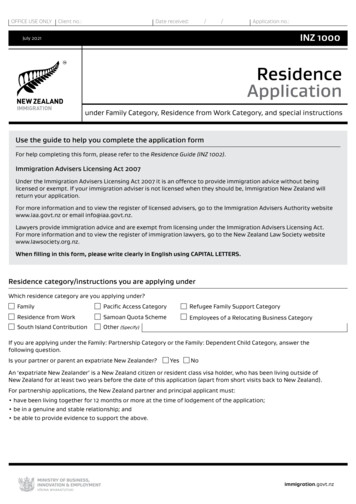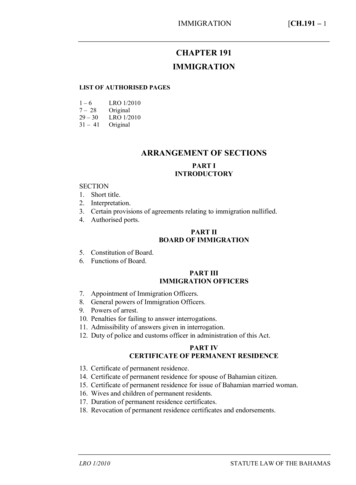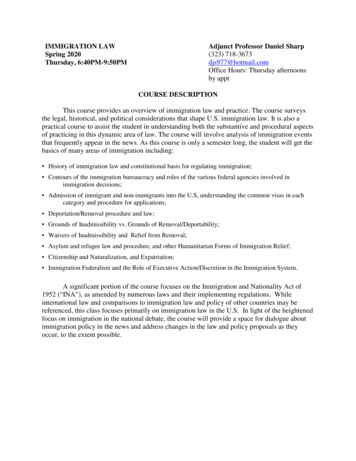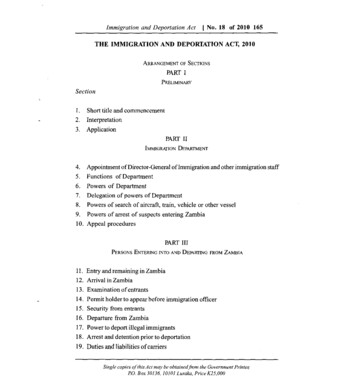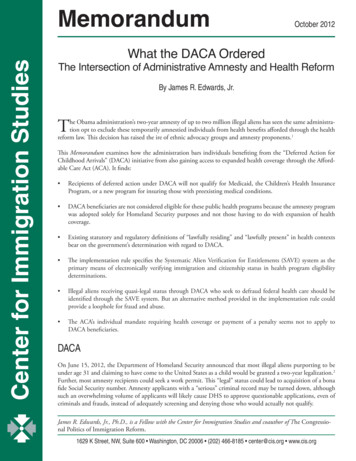
Transcription
MemorandumCenter for Immigration StudiesOctober 2012What the DACA OrderedThe Intersection of Administrative Amnesty and Health ReformBy James R. Edwards, Jr.The Obama administration’s two-year amnesty of up to two million illegal aliens has seen the same administration opt to exclude these temporarily amnestied individuals from health benefits afforded through the healthreform law. This decision has raised the ire of ethnic advocacy groups and amnesty proponents.1This Memorandum examines how the administration bars individuals benefiting from the “Deferred Action forChildhood Arrivals” (DACA) initiative from also gaining access to expanded health coverage through the Affordable Care Act (ACA). It finds: Recipients of deferred action under DACA will not qualify for Medicaid, the Children’s Health InsuranceProgram, or a new program for insuring those with preexisting medical conditions. DACA beneficiaries are not considered eligible for these public health programs because the amnesty programwas adopted solely for Homeland Security purposes and not those having to do with expansion of healthcoverage. Existing statutory and regulatory definitions of “lawfully residing” and “lawfully present” in health contextsbear on the government’s determination with regard to DACA. The implementation rule specifies the Systematic Alien Verification for Entitlements (SAVE) system as theprimary means of electronically verifying immigration and citizenship status in health program eligibilitydeterminations. Illegal aliens receiving quasi-legal status through DACA who seek to defraud federal health care should beidentified through the SAVE system. But an alternative method provided in the implementation rule couldprovide a loophole for fraud and abuse. The ACA’s individual mandate requiring health coverage or payment of a penalty seems not to apply toDACA beneficiaries.DACAOn June 15, 2012, the Department of Homeland Security announced that most illegal aliens purporting to beunder age 31 and claiming to have come to the United States as a child would be granted a two-year legalization.2Further, most amnesty recipients could seek a work permit. This “legal” status could lead to acquisition of a bonafide Social Security number. Amnesty applicants with a “serious” criminal record may be turned down, althoughsuch an overwhelming volume of applicants will likely cause DHS to approve questionable applications, even ofcriminals and frauds, instead of adequately screening and denying those who would actually not qualify.James R. Edwards, Jr., Ph.D., is a Fellow with the Center for Immigration Studies and coauthor of The Congressional Politics of Immigration Reform.11629 K Street, NW, Suite 600 Washington, DC 20006 (202) 466-8185 center@cis.org www.cis.org
Center for Immigration StudiesThe “Deferred Action for Childhood Arrivals” initiative unilaterally applies an exception-making policy known as“deferred action”, normally reserved for use on an extraordinary, case-by-case basis, to an entire class of illegal immigrants.3 This step is remarkable for its breadth, covering about one-fifth of the estimated illegal population, as wellas its wholesale application of what can only be described as turning the exception into the rule.The amnesty stratagem came about because Congress has declined to enact the DREAM Act legalization bill, despiteits being introduced in a string of Congresses. The DREAM Act would confer permanent legal status on the sameclass of illegal aliens as DACA. The bald-faced exercise of enacting, by executive branch fiat in defiance of congressional will, any policy outcome that rightfully remains the prerogative of the legislative branch disregards the separation of powers delineated in the U.S. Constitution. Border Patrol and Immigration and Customs Enforcementrank-and-file have sued over the action.The Obama administration’s highly controversial move has engendered broad speculation that the White Housesought to award a political favor to a particular group of political allies leading up to the presidential election. Homeland Security asserts that the unprecedented application of this limited discretion relates to aligning its enforcementpractices with its enforcement priorities.Health ReformThe Affordable Care Act, which became law in 2010, and which the U.S. Supreme Court upheld in 2012, containsseveral provisions intended to extend health coverage and reduce the number of individuals without insurance. Effective 2014, the ACA expands Medicaid coverage to those earning up to 133 percent of the federal poverty level.It institutes a graduated subsidy for those with household incomes between 133 percent and 400 percent of thepoverty level. Medicaid, a medical care welfare program, will also be extended to childless adults. Federal mandateson insurers require allowing adult children up to age 26 to obtain health coverage through their parents’ insurance(the “slacker rule”). Both subsidy level determinations and Medicaid eligibility will occur through health care “exchanges” operating in each state.In addition, a short-term program affords health coverage to individuals with preexisting medical conditions, thePreexisting Condition Insurance Program.As discussed elsewhere, the ACA statutorily limits qualification for Medicaid and insurance premium subsidies tothe “lawfully present”.4 Illegal immigrants are exempted from the law’s mandate requiring individuals to have healthinsurance or face a fine (which the Supreme Court renamed a “tax”).The DACA-Health Reform NexusTwo-year relief from possible removal and de facto legal status, particularly with respect to beneficiaries who obtain awork permit, inevitably raise questions about beneficiaries’ eligibility for various federal benefits. The administrationhas answered some of those questions with regard to health programs.Medicaid, CHIP, PCIP. The Department of Health and Human Services’ Centers for Medicare and Medicaid Services (CMS) on July 30, 2012, published an interim final rule that excluded DACA aliens from certain ACA healthprogram eligibility.5 On August 28, CMS informed state Medicaid directors: “Because the reasons that DHS offeredfor adopting the DACA process do not pertain to eligibility for Medicaid or CHIP [Children’s Health InsuranceProgram], HHS has determined that these benefits should not be extended as a result of DHS deferring action underDACA. For this reason, individuals with deferred action under the DACA process shall not be eligible for Medicaidand CHIP under the CHIPRA state option.”62
Center for Immigration StudiesIn other words, the stated intention for granting this amnesty relates solely to DHS immigration enforcement priorities. The decision does not relate to Medicaid and CHIP expansion under health reform. Therefore, HHS doesnot regard the immigration initiative as encompassing the extension of health program eligibility to DACA beneficiaries. CMS has issued further notice that DACA aliens are ineligible for the preexisting condition program, for thesame reasons as declining DACA’s application to Medicaid and CHIP.7Further, CMS based its conclusion on previously set Medicaid and CHIP statute and regulatory definitions of “lawfully residing”, the term that appears in the 2009 CHIP reauthorization law. Illegal aliens may not enroll in thesesafety net programs and may only obtain emergency medical treatment at taxpayer expense. CMS guidance of July1, 2010, states, “[P]eople who are undocumented were not eligible for Medicaid (except for emergency services)before PRWORA [welfare reform], and remain ineligible under CHIPRA [CHIP reauthorization].”8 CMS explains,“In interpreting ‘lawfully residing’, we will rely on existing immigration regulations for the purpose of defininglawful presence and longstanding Medicaid rules to establish residency.”9 This means established immigration rulesdetermine whether an alien’s presence in the United States is lawful and standing rules governing Medicaid residency(i.e., determining one’s state residency) apply to health program qualification within a given state.CHIPRA chipped away at welfare reform, including its five-year waiting period for legal immigrants to qualify forprograms like Medicaid, their financial reliance upon the immigrants’ sponsors’ incomes, and other safeguards oftaxpayers through public charge doctrine.10 CHIPRA allowed states to cover all immigrant children and pregnantimmigrant women through Medicaid and CHIP, regardless of welfare reform’s personal responsibility requirements.However, CMS seems to draw the line on DACA as not qualifying its quasi-legal aliens for these health programs.Lawfully Present. CMS’s 2010 CHIPRA guidance asserts that alien children or pregnant women regarded as “lawfully present” include certain aliens paroled for under a year, while disqualifying those “paroled for prosecution, fordeferred inspection, or pending removal proceedings”.11 Other beneficiaries of medical welfare coverage includecertain temporary residents, aliens granted Temporary Protected Status (TPS) with employment authorization,certain aliens with employment authorization, and aliens currently in deferred action status. It is important to notethat CHIPRA left it to the states to decide on expanding Medicaid and CHIP coverage; that is also effectively theruling of the Supreme Court on Medicaid expansion in the ACA. This expanded coverage and the descriptions ofthose newly eligible under CHIPRA applied only to immigrant children and pregnant women. Intent to expandcoverage plays in CHIPRA, not ACA.The potentially most relevant parts of the CHIPRA guidance letter’s “lawfully present” definition, as it relates toDACA, are those aliens who secure employment authorization and those in deferred action status. However, the2012 CMS guidance specifically states that DACA amnesty recipients do not qualify for the Medicaid and CHIPprograms, including those who may obtain a work permit.Eligibility Verification. Section 1411(c)(4) of the health reform law requires verification of individuals’ eligibilityfor participation in health programs based on citizenship and immigration status. The July 30, 2012, Federal Registernotice implements this provision.CMS cites the existing mechanism used for verifying individuals’ immigration status for means-tested programeligibility. The rule specifically names the Systematic Alien Verification for Entitlements (SAVE) system. “In manycases, states may be able to automate verification of citizenship and immigration status by leveraging existing dataexchanges that are currently in place for other programs, such as Medicaid and the Children’s Health InsuranceProgram. The Department of Homeland Security’s U.S. Citizenship and Immigration Services (USCIS) SystematicAlien Verification for Entitlements (SAVE) program provides [an] online system to verify an individual’s immigration status.”12 Thus, the SAVE system would seem to serve as the default electronic verification for program eligibility for health reform.3
Center for Immigration StudiesThe rule also provides states an alternative means of conducting immigration status verification for health programs,which the health law allows. States unable to have an electronic verification process in place by the time PCIP enrollment begins “may instead require the individual to provide documentation that establishes citizenship or immigration status. Subject to HHS approval, states using documentation procedures may switch to an automated systemin the future.”13Therefore, CMS has taken a step toward use of the established SAVE program as the electronic verification employedfor ACA. It should be capable of identifying and declining public health benefits to DACA recipients who attemptto defraud the government. However, the provision of an “alternative method” of verification remains a potentialloophole.Coverage Mandate. Health reform exempts illegal aliens from both the individual mandate to have health insuranceand the fine for failure to have coverage. Despite the fact some DACA beneficiaries will get work permits and SocialSecurity numbers, their ability to stay in the United States under quasi-legal status remains tentative. At heart, theDACA class of illegal aliens remains illegal aliens. Thus, they escape the requirement to obtain health coverage orelse pay a monetary penalty, which the health law imposes on legitimate U.S. residents.There is little to keep quasi-legal DACA residents from obtaining private health insurance coverage. Many will beoffered health benefits through employment, and younger people typically enjoy lower insurance premiums becausethey tend to be healthier than older people. A complicating factor will be if their employer seeks employmentconnected health insurance through an exchange, depending on the citizenship and immigration status verificationsystem used in that state. This should identify those not qualified on immigration status for premium subsidy orMedicaid. Whether or not they become insured, DACA recipients will still receive emergency care at hospitals andcommunity health clinics, billed to Medicaid.ConclusionThe DACA amnesty seeks to achieve through administrative means a policy goal the Obama administration hasfailed to achieve legitimately, through the legislative process: legal status for younger illegal aliens who claim to havecome to this country before turning 16. The health reform law now being implemented seeks to cover most U.S.residents with some form of health insurance, either in a public program such as Medicaid or a private insurancepolicy.The administration’s exercise of “deferred action” on a wholesale basis, though legally suspect and constitutionallyunsound, falls short of granting a bona fide “immigration benefit” to DACA amnesty recipients. Thus, it is wise notto regard these people as covered under health reform’s benefits (or liabilities). To do so would add insult to injuryto both health and immigration policy and further complicate a nettlesome policy intersection.Further, these illegal aliens’ status remains insecure beyond two years. Many of the relevant provisions of the healthlaw will not become effective until 2014, leaving these aliens a short window to qualify for public health programsbefore their provisional immigration status expires. Extending health benefits to those lacking an immigrationbenefit and for a fairly short term would unnecessarily put at much greater risk the true victim here: the Americantaxpayer. Such an unwise move would consume vast amounts of limited public resources that otherwise could gotoward the coverage of legitimate U.S. residents.4
Center for Immigration StudiesEnd NotesRobert Pear, “Limits Placed on Immigrants in Health Care Law”, The New York Times, September 17, 2012.1Janet Napolitano memorandum, “Exercising Prosecutorial Discretion with Respect to Individuals Who Came tothe United States as Children”, June 15, 2012.2See Jessica Vaughan, “The Hinder the Administration’s Legalization Temptation (HALT) Act (H.R. 2497)”:3Deferred action is a more formal way of exercising prosecutorial discretion that is available to USCIS, ICE andCBP. There is no statutory basis for this form of relief, but it is well established as a matter of policy. However,the lack of statutory guidelines makes it especially susceptible to abuse. Deferred action enables the governmentto make a formal determination not to pursue removal of an unqualified or unlawfully present individual for aspecific period of time, usually for extraordinary humanitarian or law enforcement purposes. For example, someforeign students affected by Hurricane Katrina were granted deferred action, as were Haitians who fled to theUnited States on nonimmigrant visas following the earthquake in 2010. As with other forms of relief, beneficiaries can receive a work permit.The immigration agency has traditionally held that deferred action is a tool that exists for the convenience of thegovernment, and is not an immigration benefit per se, and it has resisted organized pressure to formalize the application process, publicize its availability, and thereby encourage more people to apply.See CIS Memorandum, “Immigration-Related Provisions of Senate and House Health Reform Bills”, November2009.4“Pre-Existing Condition Insurance Plan Program Interim Final Rule with Comment Period”, Federal Register, July30, 2012.5Cindy Mann, CMS letter of August 28, 2012, p. 1.6“Pre-Existing Condition Insurance Plan Program Amendment to Final Rule with Comment Period”, FederalRegister, August 30, 2012.7Cindy Mann, letter to state health officials, Center for Medicaid, CHIP, and Survey & Certification, July 1, 2010,p. 2.8Ibid.9See James R. Edwards, Jr., CIS Backgrounder, “Public Charge Doctrine: A Fundamental Principle of AmericanImmigration Policy”, May 2001.10Mann 2010 letter, p. 3.11July 30, 2012, Federal Register notice.1213Ibid.5
Center for Immigration Studies October 2012 What the DACA Ordered The Intersection of Administrative Amnesty and Health Reform By James R. Edwards, Jr. James R. Edwards, Jr., Ph.D., is a Fellow with the Center for Immigration Studies and coauthor of The Congressio-nal Politics of Immigration Reform. T

